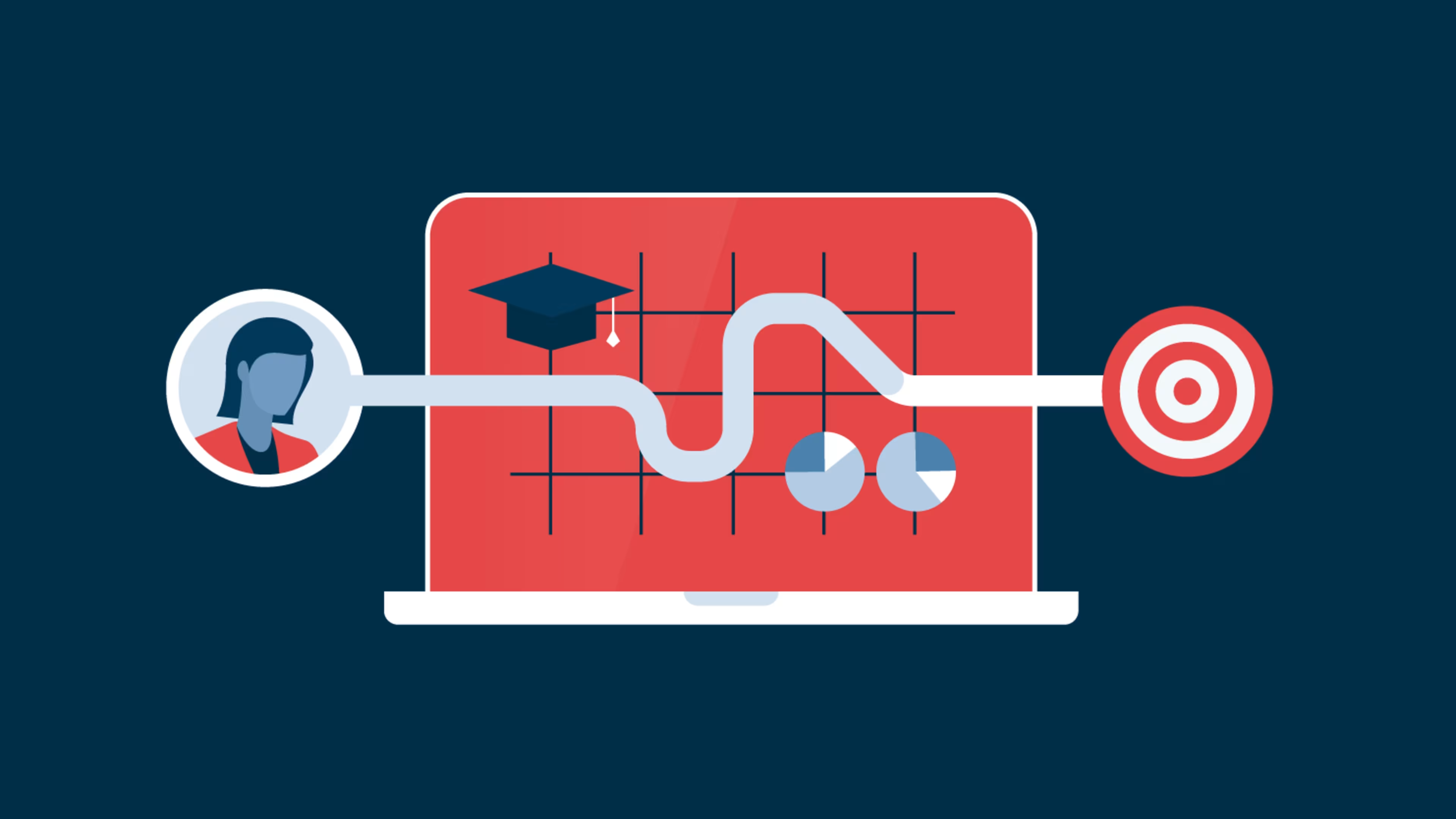Learn the six career development stages in order to fine-tune your L&D strategy.
In Capterra’s Remote Work Culture Survey* from early 2022, we asked over 950 HR professionals to rank 14 factors that influence their employees' job satisfaction from most important to least important. Compensation and work-life balance were seen as the most influential, with opportunities to advance their career following closely behind.
This reveals that HR leaders recognize that career development opportunities are hugely important to their employees, but even so, only 30% of employees that Gartner surveyed agree they have a clear path for career growth at their organization (full content available to Gartner clients).
Meaning, even though HR leaders know career development opportunities hold the key when it comes to retaining employees, the majority of them don’t have an effective strategy in place (or even know where to start). Considering that career advancement opportunities are seen as having a heavy influence on employee satisfaction (which has a direct correlation with employee retention), this is concerning.
If you’re an HR leader who’s looking to revamp your organization’s career development program in an effort to improve employee engagement and retention, this guide is for you. Ahead, we’ll give an overview of the six stages of career development and provide recommendations throughout that will help you take your own strategy from ineffective to efficient.
Note: Are you an employee who’s looking to learn more about career development? If so, skip ahead to the Capterra tools and tips section.
Ready to hire a recruiting agency for your business needs? Browse our list of companies in the following areas:
What are the main stages of career development?
The following stages are adapted from Michelle L. Casto’s book, "Get Smart! About Modern Career Development: A Personal Guide to Creating Your Life's Work." While Casto’s version is based on the journey of recent college graduates, we’ve adapted the stages so that they can be applied to anyone at any point in their career.

Additionally, we’ve added to-do’s under each step so that you know exactly how to keep the process moving along. It’s worth noting that these responsibilities may be handled best by either an HR professional or a team manager depending on the size of your organization.
1. Assessment
In the assessment phase, the employee in question “assesses'' their interests and skill set in order to determine which direction their career should go. While this mostly entails their own independent brainstorming, receiving feedback from mentors and managers can help them understand their professional strengths and weaknesses.
to do
Encourage employees to fill out an individual development plan (IDP). Doing so will require your employees to take an active role in their own career planning which means they’ll be more invested in the development process. If you need an IDP template, there’s one available to download for free in Looking For a Career Pathing Template? The Search Ends Here.
2. Investigation
As the name suggests, this stage of career development is all about investigating the options the employee has available to them. In the context of our application (which would be to offer development guidance with the hope that the individual will stay and grow with your organization), this could mean talking to coworkers in other departments, shadowing a role that’s of interest, or even taking an eLearning course to cultivate a new skill.
to do
Facilitate opportunities for team members to learn about roles or departments outside of their own that they could see themselves succeeding in. One way to do this is through a mentorship program, where more tenured employees volunteer to spend a few hours explaining or demonstrating their day-to-day responsibilities to coworkers.
3. Preparation
The preparation stage occurs once an employee has chosen a career path to pursue and begins to work toward it. Of course, the preparation required to transition to a new role will be different for every employee, but the idea is to set development goals and start progressing through the steps it takes to reach them. This may mean upskilling through formal training, independently studying subject matter, or gaining experience on-the-job by contributing to projects outside of their normal role.
to do
Work with your employees to create development plans with specific milestones. Start by listing the soft and hard skills they’ll need to be successful in the role they’re pursuing, then create a proposed schedule of training and shadow sessions that will help them gain said skills.
4. Commitment
Once the employee has met the requirements to transition to a new role, they’ve entered the commitment stage of the development process. At this point, they should be interviewing for or ramping up to take on the responsibilities that come with their new position.
to do
Skill demands ebb and flow, but when there’s an opening in a department or team that aligns with your employee’s career goals, make sure they’re aware of and encouraged to pursue the career advancement opportunity, whether through a formal interview or contacting the manager who oversees that role.
5. Retention
In Casto’s book, the retention stage (sometimes called the establishment stage) refers to the period of time when the employee has reached their career goal and has become well-established within their new role. Reaching the retention phase would mean that the employee is confident in their ability to manage all of the daily, weekly, and monthly responsibilities associated with their new position.
to do
Professional development shouldn’t stop once an employee is comfortable in their role. Receiving feedback from peers and managers on a consistent basis is a must to make sure that workers are successful in meeting their goals, as well as in their collaboration and communication efforts. Adopting a formal 360-degree feedback process can help with this by setting a cadence for teams to give and receive feedback.
6. Transition
Zippia reports that the average American has around 12 distinct jobs in their lifetime, which means that, inevitably, your employee will be ready for another career change at some point. And when they are, they’ve reached the transition stage.
Whether it’s curiosity or boredom that drives them to take the next step in their career journey, it’s important to continuously support your employees’ development if you’d like them to stay at your organization. Keeping tabs on your teams’ engagement levels can help reveal those that might need to revisit their career plan in an effort to determine whether they’re ready to start working toward the next step in their professional journey.
to do
As mentioned above, measuring employee engagement can help managers identify employees within their team that are ready for new career opportunities. Sending out a survey is one tactic you can use to gauge your teams’ engagement levels, or you can invest in a comprehensive employee engagement software that offers features such as feedback collection and analytics.
Capterra tools and tips
ATTN: Individuals who are looking for career development advice.
While this guide may give you a valuable glimpse into the stages of a typical career development process, this segment is just for you. Below, see three tips we have for individuals seeking career planning advice.
Brainstorm career goals you’d like to achieve. If you met yourself in five, 10, or 15 years, what would you hope to have accomplished? This career exploration exercise should help you hone in on the potential directions your career can take.
Create a professional development plan. We’ll let you in on a little secret: You can develop new skills and gain experience without the support of your workplace (though that does help). In order to make sure you’re progressing toward your goals, try creating an IDP. Check out our free, downloadable career pathing template that includes an IDP section to get started.
Build professional connections by asking for guidance. There’s a theory in modern psychology that asking someone for help builds an instant bond. Why not test it out by asking someone whose career you admire how they got where they are? You never know what sending a coworker an email or a LinkedIn connection a message could lead to.
Leveling up your development strategy = a higher chance of retaining quality employees
Capterra’s Remote Work Culture Survey* from early 2022 revealed that a majority (87%) of HR leaders agree that their employee learning and development (L&D) program will be critical to retaining talent in 2022. However, less than half (48%) are actually increasing their L&D budget for the year.
Over 4.5 million American employees left their jobs in March of 2022, but it’s not too late to invest in your L&D strategy in an effort to keep your employees around. Understanding the six career development stages, and how to guide employees through them is a great start, so to recap:
Assessment: Employees assess their professional interests and current skill set.
Investigation: Employees take steps to further explore career paths.
Preparation: Managers create development plans based on their employees’ interests.
Commitment: Employees seek and go after career advancement opportunities.
Retention: Employees thrive and grow in their new role.
Transition: Employees determine they are ready for another career change.
When you’re ready to learn more about leveling up your L&D strategy, we’ve got you covered with the resources below:
First, visit our learning management systems (LMS) buyers guide, a comprehensive resource that explains what these tools are and how businesses use them to develop and upskill their workers.
Lastly, don’t miss our career pathing content. Career pathing is a part of every great L&D strategy, and we’ve got you covered with a full explanation of the process and a free template to get you started.

